BugRobotics
Stainless
- Joined
- Jun 22, 2015
- Location
- Denver, CO
And yea, I shouldn't have used the term "controller"
Follow along with the video below to see how to install our site as a web app on your home screen.
Note: This feature may not be available in some browsers.
Those are not the correct wire numbers. The red wires go to the Start/Stop station and prevent the MG from starting unless the switch is in the center (spindle stopped) position.The drum switch has wires with metal tag numbers, 1, 2 and 3.
Red one, #1 & #2
Black ones #1, #2 and #3.
View attachment 343903
DC Control Panel (on the right). The terminals are at the bottom. Terminal labels are above each terminal. Wires have metal tags that identify them.
Cal
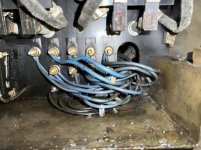




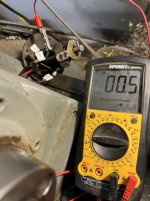


First step of troubleshooting is thou shall check voltages so yea, voltage measurements are gonna be in your future if the switch and wiring is indeed not the issue.
I'm going out on a limb here but what happens if you move the drum switch slightly while checking continuity. Idea being the switch may be prevented (dirt/wear) from switching all the way when installed. Not hard to check so you could check that off the list.
I get what Tony is saying about how to check the voltage across a switch. This means I will power up the lathe with the drum switch removed, in order to access the switch contacts. That will take some care as my only access to the drum switch is by leaning over the bed, quite close to the spindle, if I'm understanding correctly.
However, I think I do not fully understand what you are suggesting. I think I get what you mean about rotating the drum switch slightly to check continuity, but from what position? From closed where there is continuity, to see if that circuit is broken as the switch moves slightly? How would the switch be prevented from switching all the way when installed? I can tell you that the switch rotates quite easily by hand, so there would have to be some fault in the mechanical connection between the switch shaft and the actuating lever/shaft operated from the front of the machine. That is such a direct connection, it is just the slot in the shaft that receives the switch shaft/dowel pin. Do those slots get enlarged by wear? Or?
I'm grasping at things, trying to understand. I can do the slight movement continuity test, but please elaborate a bit more on what might be leading to the switch not getting rotated enough.
Thanks,
Rick
It could be a sticky AP (Anti-Plugging) relay. The AP relay is at the top of the DC panel, in the middle. It should close immediately after the spindle stops. Crud can build up on the moving arm and cause it to stick in the open position. The AP relay doesn't open until about 400 RPM (at the motor) so if you turn the speed control all the way down, you should be able to start and stop the spindle without it sticking open. Keep an eye on the AP relay when you stop the spindle at speeds above 400 RPM and see if it's sticking.Pulled the C1, C2 and C3 wires from the DC Panel and labelled them. Did a continuity check from each labelled DC panel wire to the drum switch. Labelled the drum switch wires accordingly. Reassembled switch into headstock and powered it up. Same behavior. First time rotating the drum switch, spindle turns immediately. Subsequent rotations of the switch, does not run/turn. Previously, it would run again fairly quickly but recently, it doesn't run at all, even if wiggled or left in that position. It has on occasion started after being left in the Forward position for a little. I don't like doing that so I have never left it that way long or diverted by attention. ...
It could be a sticky AP (Anti-Plugging) relay. The AP relay is at the top of the DC panel, in the middle. It should close immediately after the spindle stops. Crud can build up on the moving arm and cause it to stick in the open position. The AP relay doesn't open until about 400 RPM (at the motor) so if you turn the speed control all the way down, you should be able to start and stop the spindle without it sticking open. Keep an eye on the AP relay when you stop the spindle at speeds above 400 RPM and see if it's sticking.
The resistors at the top-right of the panel are on their way out and need to be replaced. Two of them are related to the operation of the AP relay, but won't cause the symptom that you describe. We can talk about that later.
Cal
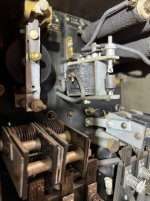
I am having trouble with the AP relay again. I've reviewed this thread and the linked issues. I've cleaned the relay in every way I can think of. Photos inserted below. This has not fixed the problem. In the past, this did relieve the problem for a time but it seems to be worse than before in that I have to manually release the relay after just about every time turning the spindle off. I've taken to leaving the covers off as I have to lean over and jiggle the relay arm. When I do, it seems very stuck, and more so than in the past.Probably what's going on is that there's enough sticky, oily stuff accumulated between the horizontal arm and the end of the coil that the arm is sticking to the coil. (I'm talking about the relatively heavy arm with the larger spring attached to one end, not the smaller arm with the actual contacts). Get a piece lint-free cloth (old cotton T-shirts are ideal), dampen with isopropyl alcohol or electric contact cleaner, feed it between the arm and the coil, then push the arm against the coil and gently pull the cloth out. Repeat until the cloth comes out clean. There's a little shoe at the end of the arm that may also be the culprit. A little contact cleaner there might do the trick, but don't get carried away. Most hardware stores carry electric contact cleaner. Let me know how that works.
Here's a link with information about replacing the resistors: Start up problem with m/G machine?
Cal


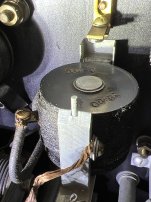
Thanks, Cal.If the AP relay is the problem, you can make the machine run by connecting a jumper across the terminals. The top bolt is one terminal and the bottom pair of bolts (and the frame of the relay) are the other. The machine will run just fine without the AP relay, but you should make sure that you let the spindle come to a full stop before changing directions.
The resistors will not cause problems starting the machine. If the 2000 Ohm B-E resistor is bad, the spindle will cycle on and off repeatedly above a certain speed.
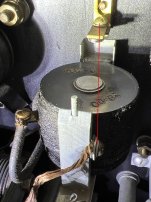

Reversing a DC motor while it's running, by changing the polarity of either the armature or field, is called "plug reversing". If you do it at full speed it can damage the motor. The AP (Anti-Plugging) relay prevents you from plug reversing the motor.Thanks, Cal.
I do not change directions much at all. I think waiting for it to come to a complete stop before reversing would not be a problem. But, it is possible to do that by accident. Just so I know the risks, what are the consequences should that happen?
Would jumping as in the photo below be what you are meaning? These locations look to be the easiest to connect to and do not involve attaching anything to the moving part. Or would it be better to remove the relay from the circuit by disconnecting the lead on the left side and extend it to the brass tab above the rely, as in the second photo?
Are there any opportunities get a replacement rely?
Rick
View attachment 394233

Notice
This website or its third-party tools process personal data (e.g. browsing data or IP addresses) and use cookies or other identifiers, which are necessary for its functioning and required to achieve the purposes illustrated in the cookie policy. To learn more, please refer to the cookie policy. In case of sale of your personal information, you may opt out by sending us an email via our Contact Us page. To find out more about the categories of personal information collected and the purposes for which such information will be used, please refer to our privacy policy. You accept the use of cookies or other identifiers by closing or dismissing this notice, by scrolling this page, by clicking a link or button or by continuing to browse otherwise.
